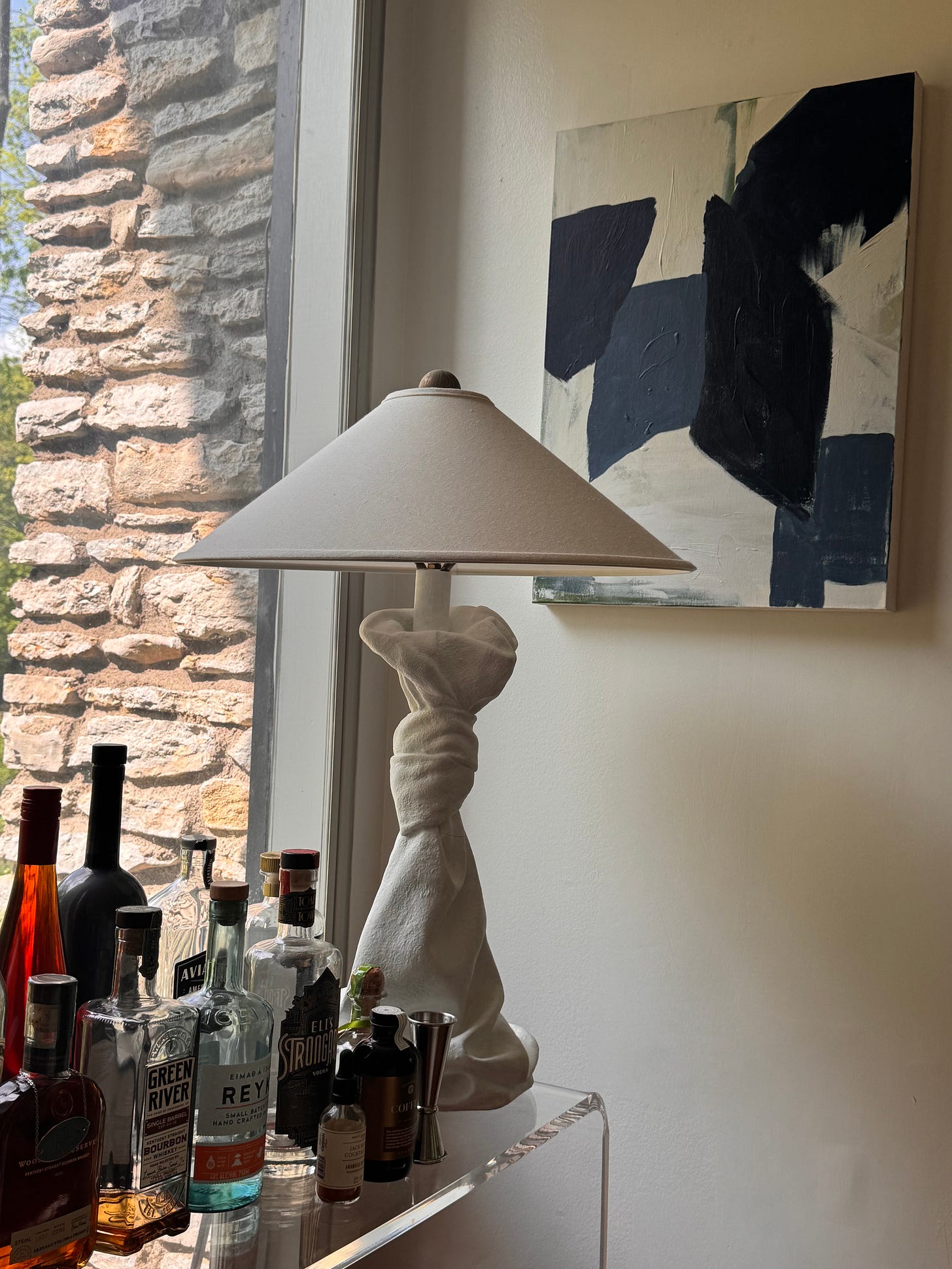The Curated Collector -- Art Edition
Make people wonder if you have an inside connection with an art dealer by filling your walls with meaningful and well appointed artwork.
Perhaps more than any other design element in a home, the art that adorns our walls and fills our bookshelves gives the most insight into a homeowner’s personal style and history. A painting from a vacation overseas, a photo of a loved one, even a child’s first finger painting from art class – these all help us to commemorate the special times and people in our lives. Art is also a surefire way to bring life and depth to a room. The selection of such important pieces can understandably be a daunting task (not to mention the math required for correct hanging). Fear not, my design loving friends. It doesn’t have to be so hard.
The biggest obstacle when beginning an art collection is typically price – original art is not cheap. This often causes people to flock to big box retail stores for multiple prints and canvases that quickly fill blank walls on a budget. Believe me, I’ve been there. I bought the massive black and white print of the shaggy haired Highland cow from West Elm. I also bought the geometric tribal prints from Target. They did in fact fill empty wall space, but they also left me with an empty feeling. They were just placeholders with no real significance to my life or interests.
So how does one select meaningful art on a real-life budget? You simply must think outside of the box (or outside of the standard picture frame in this instance). Literally ANYTHING can be art. I have used polaroids from a wedding photo booth, old pictures of family members, newspaper clippings and even a ceramic paw print of a beloved pet. The key to making these ordinary objects feel extraordinary is the framing. I am fortunate to have an incredible frame shop in town that can elevate even a simple photograph to a work of art with special attention to the mat and frame. The endless possibilities for framing materials can be overwhelming, which is why it is important to find a reputable person to help guide the process.
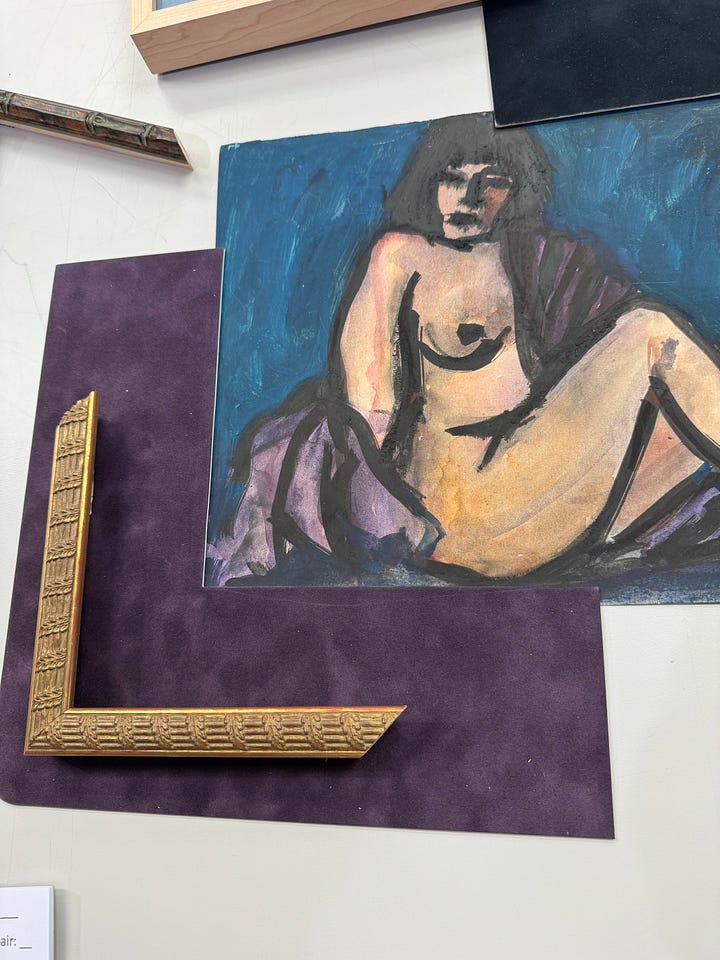

Let’s start with photos of loved ones. Although I am not a fan of framed photos on every tabletop and shelf, everyone has at least one photograph that looks like it should be a movie poster. The photo that makes guests wonder why you never mentioned your grandmother was a 1950’s socialite constantly chased by paparazzi. Take that photo, convert it to black and white, blow it up poster size and finish it off with a handsome frame. Not only will you have large scale, personal art, but you will also be pleasantly reminded of your loved one every time you pass. Additionally, there is nothing more chic than black and white photography. It can blend seamlessly with any décor, and the frame can lean either modern or traditional based on your design preference.

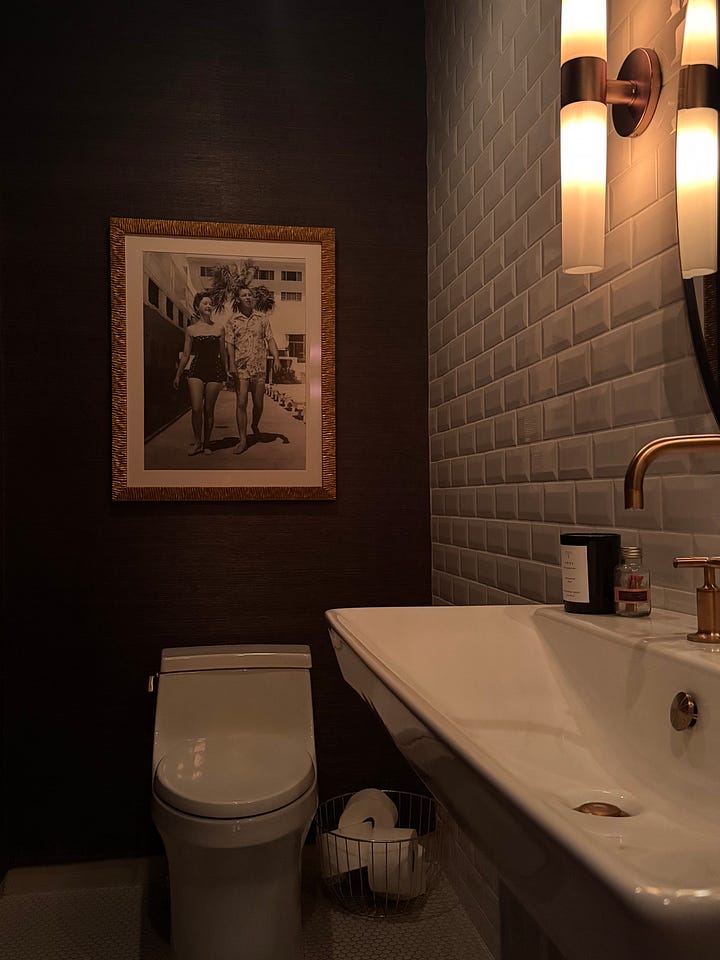
The slightly more difficult move in curating an art collection is finding original paintings. Many people overthink this decision and focus on finding art with the perfect colors or even theme to match a given room. Although these aspects are important to consider, art that excites you or reminds you of a fond life event can always find a place in your home. When you come across such a piece, buy it on the spot. If you’re anything like me, you’ll regret the missed opportunity when someone else purchases it first. In terms of where to look for such art, I gravitate to vintage stores because of the affordability and vast array of styles available. One of my favorite pieces of art was found perusing Scout Antique & Modern. It checked all the boxes –large size, moody vibes and my favorite blue/green color scheme. I hesitated because a massive canvas was not on my shopping bingo card that day, but after thinking about it nonstop for the next twenty-four hours, I decided it had to be mine. I was only two steps into the shop when one of the vendors greeted me and asked “Back for the painting? I think we can work out a deal.” Now it hangs proudly in a hallway just off my kitchen where I can enjoy it every morning over coffee.
Fortunately for me, that painting did not require a new frame. I have, however, purchased or inherited many pieces of art that were either unframed or were not framed to my taste. This is where the custom frame shop comes in handy. A frame can bring new life to a piece of art. For instance, I once purchased a large canvas from a local vintage store at an incredibly affordable price. It hung on my wall, unframed, for years. Although I loved the painting (an abstract nude of a mysteriously posed woman), it always felt a little off – almost like it was lost on the big blank wall. I finally decided to frame the piece in an ornate gold frame which I conveniently found on the clearance wall of my frame shop. Suddenly, the painting had a new life and a more impactful presence on the wall. It finally felt finished.
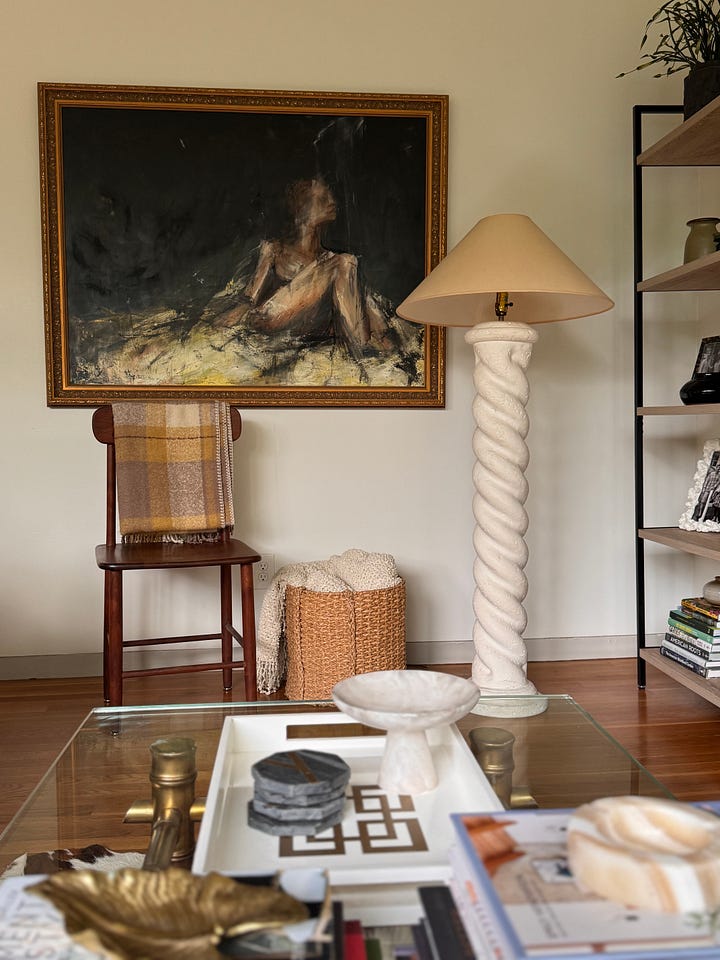
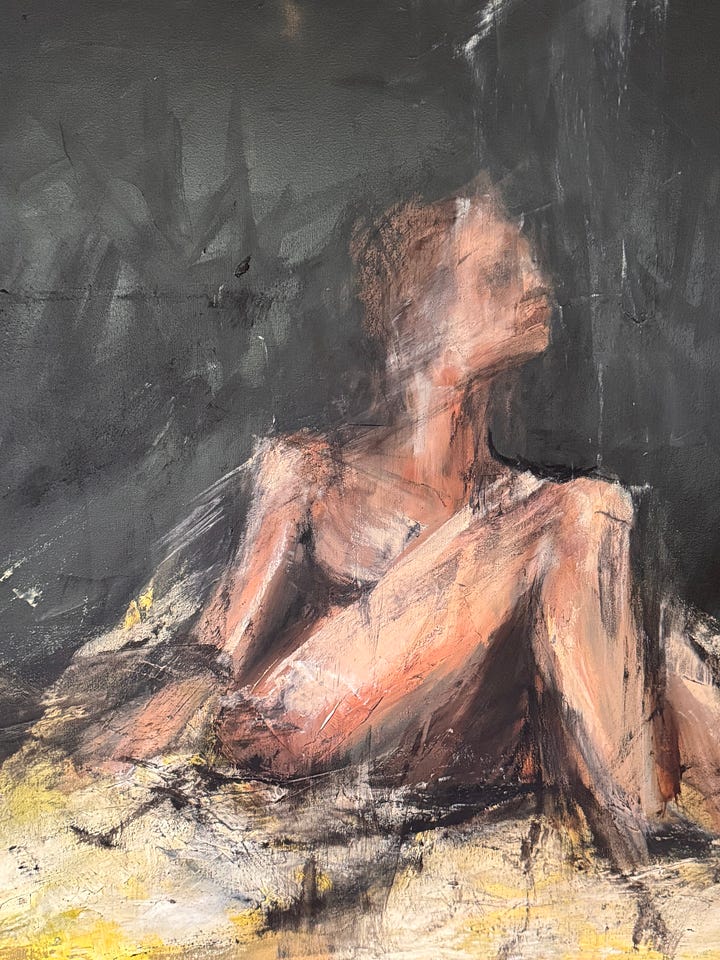
Even though I will be the first person to wax poetic about the artistry involved in choosing a special mat and frame, not every piece needs one. A good example of this is an abstract canvas hanging in my living room which was painted by a friend from my hometown (budget tip – make friends with artistic people who will paint super cool art for you at a discount price). This friend is unbelievably stylish and wanted to try her hand at painting. As one of her first commissioned pieces, I basically just paid for the supplies and came away with a truly unique painting that anchors my bar area. It hangs in a small corner between two windows, and is in close proximity to the table lamp and bar top. This arrangement makes it feel part of the entire vignette and allows it to stand alone as just the unframed canvas. It may get framed someday, but for now I love it just as is.
My favorite party trick with art is framing an object that typically wouldn’t be considered “art.” The most unconventional object I have framed is a thirty-something year old newspaper advertisement for a small-town liquor store and bar previously owned by family. My parents had given me a box of long forgotten champagne flutes that had been wrapped in newspaper and tucked away in the back of a closet. I couldn’t help but flip through the newspaper pages to see what was happening in Owensboro, KY way back in 1988. When I saw the old liquor and bar advertisements, I knew they had to be commemorated. I am so glad I did because the liquor stores have since been sold and now those yellowed advertisements are a very special timestamp in my family’s history. Also, how else would I prove that you could order an all- you-can-eat spaghetti plate and wash it down with a Kahlua cocktail for less than $5?
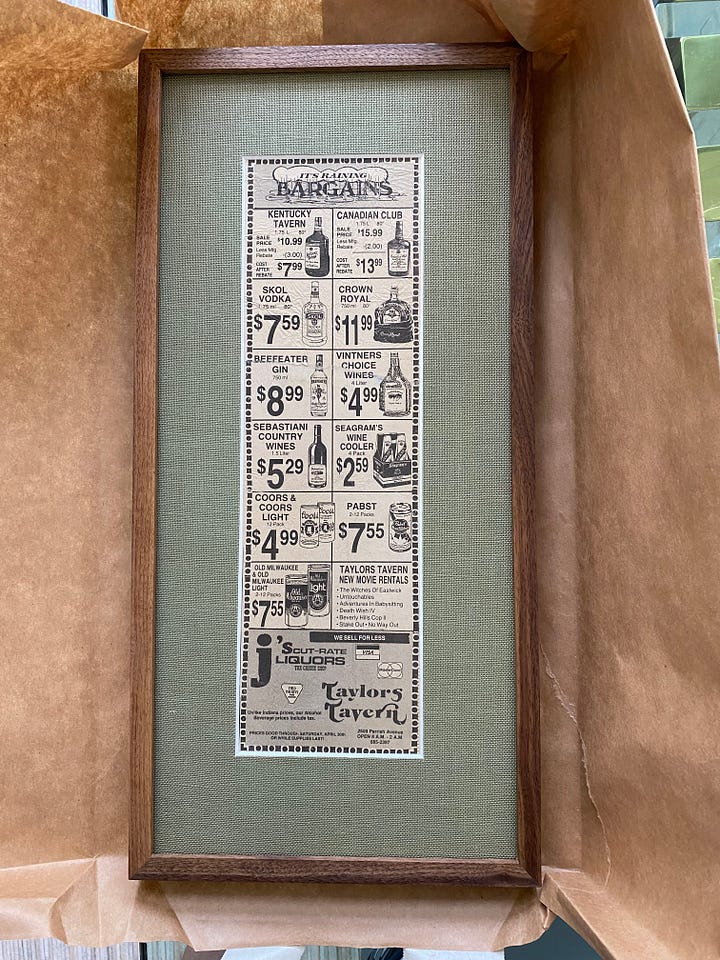


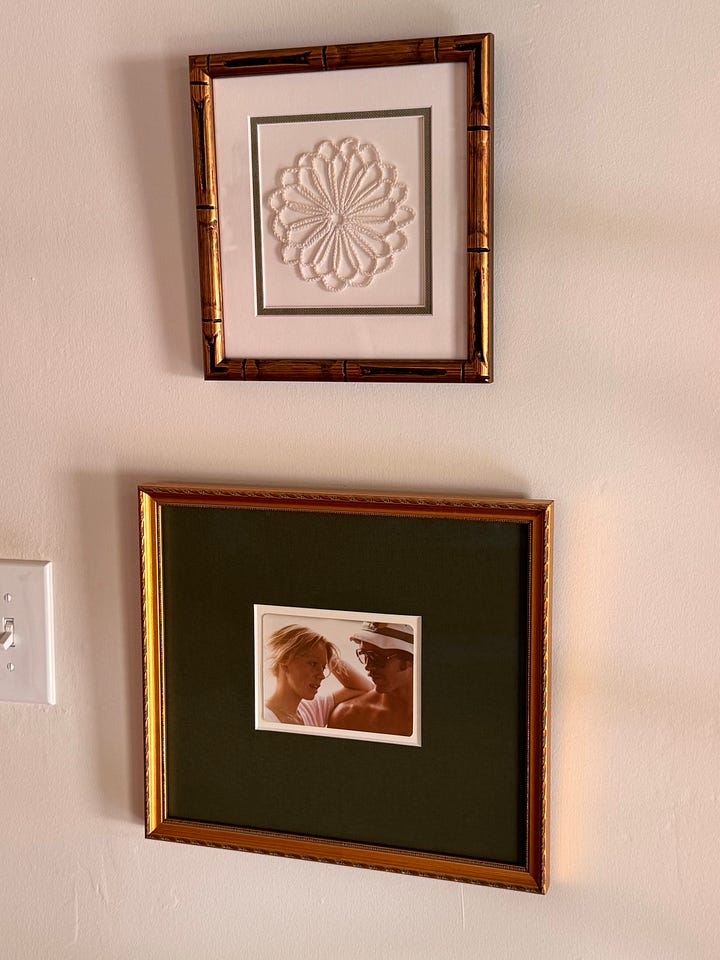
Now for the most challenging part of the whole process – deciding how high to hang the art you have chosen. The true answer to this question is “it depends.” However, there are some general guidelines to follow.
1) Art on a blank wall should be hung with the center of the piece at eye level for the average person which typically means 60 inches (give or take) from the floor.
2) If the art is being placed above a piece of furniture, forget the 60 inches rule. It is usually a safe bet to hang the piece so the bottom of the frame is six inches above the top of the furniture. Also, don’t be afraid to lean a piece of art against the wall instead of hanging it.
3) When grouping multiple pieces together, I err on the side of closer rather than farther apart for spacing. 1 – 2 inches between frames is where I start and then adjust accordingly based on the size of the art (larger pieces feel better with more generous spacing).

A home filled with art is a happy home. It not only provides joy to those lucky enough to live with beautiful things on the walls and shelves, but it also supports local artisans and retailers – an absolute win-win situation. As the saying goes, life is short. Order the wine, eat the dessert and buy the art. True words to live by.





